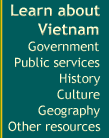











|
Culture
Sports
The 4000-year history filled with eternal wars of founding and
defending the country had tempered a martial Vietnamese nation.
This martial tradition was evidently manifested in sporting events
found in the collective activities of the Viet people from the very old
time.
In the cultural aspect, the Red River delta’s traditional rituals
is
well-known with the quan ho songs and the cheo melodies; and
in
the eyes of sportsmen, it proceeded excitingly with contests of
wrestling, wushu, swinging and playing Chinese chess. The annual
races of canoeing, swimming and diving are always fierce
competitions among young men from coastal and riverside regions.
Up in the mountainous areas, horse races, elephant races, contests
of arrow and cross-bow shooting and other sporting games like
throwing con ball have been perpetuated until today.
Under the French domination and the South Vietnam regimes,
Vietnamese national sportsmen, though being scattered in operation,
attended many international competitions in the region and finished
as champion or among the top standings many times in such
categories as soccer, boxing, cycling, tennis...
Since 1975, the Vietnamese sports and physical culture have been
truly promoted to become a widespread movement among people
with the slogan "To be strong to construct and defend the
country".
The French and American war posed big obstacles to the
development of the Vietnamese sports; nonetheless, at every
interval during these two wars, Vietnam had been hectic to
construct the preliminary infrastructure for sports. Stadiums and
training centers had been built, and more importantly, the first
training officers and managing officers of the sports branch had
undergone basic training inside the country and abroad.
A sport festival
Since the country’s unification in 1976 and especially the
introduction of the renovation process in 1986, positive social and
economic changes have pushed the sports branch to thrive.
The sports movement at grassroots levels has increasingly attracted
mass participation; millions of people of all ages have been regularly
practicing sports and physical exercises. Streets of Vietnam in the
early morning often impress foreigners by groups of people
exercising thai cuc quyen (taijiquan, a kind of traditional Chinese
shadow boxing), deep-breathing training, playing badminton and
mini-soccer. Widespread aerobic and nourishing exercise clubs
have attracted middle-aged and old people, while courses of Judo,
Karate, and Taekwondo have been a passion of the youth. Sporting
events take place all year round across the country with major
competitions of each category and sports games at local and
national levels.
Soccer is the most popular game in Vietnam. Those who concern
about soccer include not only soccer players at all levels but also
the mass of soccer fans in which many of them have not even
kicked a ball.
However, the high ranking awards of the Vietnam sports were not
given to soccer, but chess playing, kungfu and shooting. Many
Vietnamese chess players have been conferred with Prominent
Player and Great Prominent Player Honors by the International
Chess Federation, namely, Hoang Thanh Trang, Dao Thien Hai,
Nguyen Thi Tuong Van... Regarding kungfu, Wushu player
Nguyen Thuy Hien, gold medalist at the 1996 Asian Wushu
Championships, is the most prominent sporting personality of
Vietnam. Male and female players of Taekwondo, Judo and Karate
are usually a spearhead of Vietnamese sports in regional
competitions. Another Vietnamese outstanding sporting personality
is body-building player Ly Duc, the gold medalist at the 90 kg
category at the Asian Body-building Championships held in
Rangoon, Myanmar.
Recently, national records in athletics and swimming have been
continuously broken. This is truly a good news showing that
Vietnam is trying to fill the gap with international and regional
standard in these sports.
'Khi Cong' Exercise
In the integration process to the world community, some sports that
were previously unpopular with the Vietnamese are now in booming
development. Among those, tennis, horse race and golf are listed.
Before 1975, there were quite a few tennis courts in the country’s
major cities like Ha Noi and Sai Gon; today, each city
boasts
hundreds of tennis courts. Remote provinces like Lang Son,
Quangr Ninh, Dong Thap have built their tennis courses, while
players from small provinces, such as Soc trang or Khanh
Hoa,
are fairly strong in the national tennis championships. Visitors can
watch horse races at Phu Tho race field, Ho Chi Minh City thanks
to the restoration of the arena with complicated service required for
this sport. You can also play golf in Vietnam since nearly a dozen of
golf courses have been built or under construction. The Da Lat Golf
Course has been received A+ rank by the International Golf
Association and the Vietnam Open Golf Championship has been
officially put in the annual list of international competitions.
Although Vietnamese national players have recorded more and
more achievements at international and regional events like the
Seagames, Asiad, or Olympic Games, the Vietnamese level of
sports generally still lags far behind other countries in the region.
The immediate difficulties have been identified: poor infrastructure
and technical conditions for sporting activities and training work;
lack of managing officers and trainers and the weakness of training
quality; poorer physical conditions and limited tactics of Vietnamese
players, though having great determination, in international
competitions.
Learn about Vietnam
Government |
Public services |
History |
Culture |
Geography |
Other resources
|
|











